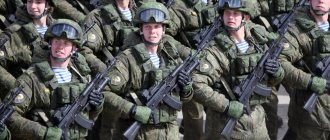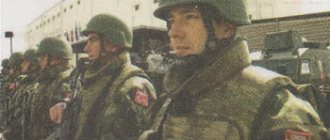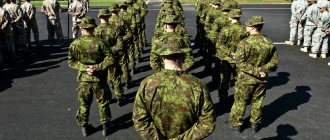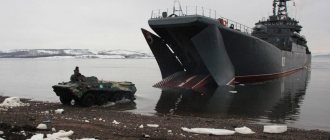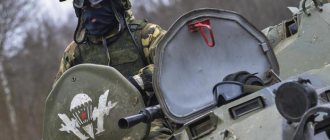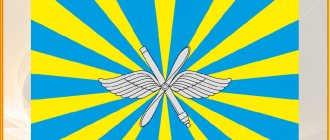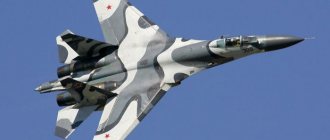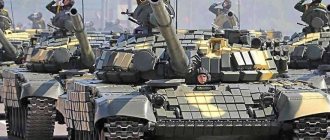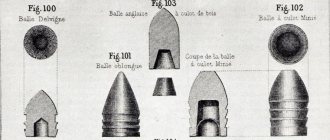A noticeable geopolitical trend in recent decades has been the rapid rise of China and its gradual transformation from a regional leader into a superpower that no longer hides its global ambitions. Today, China has the second economy in the world, and it continues to grow rapidly; more than a third of world GDP growth is already provided by China.
However, a strong economy alone is not enough to realize global ambitions. The power of a state and the respect of its neighbors - as at all times - are determined by the ability of its armed forces to defend national interests.
It should be noted that estimates of Chinese military power vary widely. From panicky materials about the “yellow” threat that can take over the whole world, to an openly dismissive attitude towards the developments of the Chinese military-industrial complex. But still, most experts recognize the successes achieved by the Chinese military leadership in recent years. So, what is China's modern army like? Should we be afraid of her?
The country's armed forces are officially called the PLA - the People's Liberation Army of China. They were founded on August 1, 1927 during the civil war, but they received this name somewhat later, after the end of World War II. Today, the PLA is considered one of the strongest armies on the planet; experts put it in second or third place in the ranking of the armed forces of the world.
In accordance with the country's constitution, the PRC army is subordinate not to the government or the leadership of the Communist Party, but to a special body - the Central Military Council. The post of Chairman of the Central Military Commission is considered one of the key ones in the hierarchy of power; currently (since 2013) it is occupied by the General Secretary of the CPC Central Committee Xi Jinping. The first chairman of the Central Military Council was Deng Xiaoping, one of the architects of the Chinese economic miracle.
As of 2013, the strength of the PLA was 2 million 250 thousand people (according to other sources - 2.6 million). In 2016, another reduction in the Chinese armed forces by 300 thousand people was announced. After the implementation of these plans, approximately 2 million people will remain in the Chinese army.
The Chinese army is a conscript army, men are recruited to serve in the armed forces at the age of 18 and remain in the reserves until the age of 50.
China continues to increase spending on defense needs: if at the beginning of the 2000s the country spent $17 billion on the army and military-industrial complex, then in 2013 this figure reached $188 billion (2% of GDP). In terms of military spending, China confidently ranks second, significantly ahead of Russia (with its $87.8 billion in 2013), but more than three times inferior to the United States ($640 billion).
The impressive successes of the Chinese defense industry should also be noted. You can forget the times when the word “Chinese” was synonymous with something cheap, low-quality and counterfeit. Today, the PRC produces almost the entire range of weapons and ammunition. If earlier China mainly copied Soviet and Russian weapons, today the Chinese defense industry is trying to imitate the most technologically advanced products from the USA, Europe and Israel.
China still lags behind Russia in some areas: aircraft and rocket engines, submarines, cruise missiles - but this gap is rapidly closing. Moreover, the PRC is gradually turning into a powerful player in the global arms market, confidently occupying the niche of inexpensive and high-quality weapons.
History of the PLA
The history of the Chinese armed forces goes back more than four thousand years. However, the modern army of the PRC is the heir to the pro-communist armed groups that appeared during the civil war that took place in the country in the 20-30s of the last century. On August 1, 1927, an uprising began in the city of Nanchang, during which the so-called Red Army was founded under the leadership of the future leader of China, Mao Zedong.
The Chinese Red Army fought against the Kuomintang armed forces, then fought against the Japanese invaders. It received the name PLA only after the end of World War II.
After the defeat of the Kwantung Army, the USSR transferred all Japanese weapons to the Chinese comrades. Chinese volunteers, armed with Soviet weapons, actively participated in the Korean War. The Soviet Union actively helped China build a new army, and very quickly, numerous and fairly combat-ready armed forces were created on the basis of semi-partisan formations.
After Stalin's death, relations between the PRC and the USSR began to rapidly deteriorate, and in 1969 there was a border conflict on Damansky Island, which almost escalated into a full-scale war.
Since the 1950s, the PLA has experienced several significant cuts, the most significant of which were carried out in the early 1980s. Until this time, the Chinese army was mainly ground, it was “sharpened” for a possible conflict with the USSR. After the likelihood of war in the north decreased, the Chinese leadership began to pay more attention to the south: Taiwan, the disputed territories in the South China Sea.
In the 90s of the last century, the PRC leadership began a program to modernize the national armed forces, which led to such impressive growth in the future. More attention was paid to the development of the navy, missile forces and air force.
Several years ago, the start of a new reform of the PLA was officially announced. Transformations are already in full swing. The principle of forming the armed forces of the armed forces has changed, new types of troops have been created. The goal of large-scale transformations is to achieve a new level of controllability of the PLA by 2022, optimize the structure of the army and create a military force capable of winning in the era of information technology.
Island of bad luck
However, China will begin a military operation only if its own victory is undeniable, since the price of military defeat is too high. If force is the only means of holding Taiwan, many factors must come together for the invasion plan to succeed.
China's superiority is great, and the Chinese have accumulated a lot of forces, but the capture of a large island, which is guarded by a fairly large army, is an operation the likes of which have not been carried out since World War II
Vasily KashinDirector of the Central Committee for Meteorological Research of the National Research University Higher School of Economics
Firstly, only a tenth of Taiwan is suitable for landing, which practically eliminates the element of surprise. At the same time, the number of troops guarding the island is approximately 130 thousand people, as well as thousands of military vehicles and artillery pieces. This automatically makes an offensive against such a force a complex operation, which not every army is capable of. China has no experience of such hostilities. Secondly, even if the United States does not intervene, the landing and occupation of the island does not guarantee success for China, because its army will have to occupy territory with 23 million hostile islanders.
The Taiwanese Ministry of Defense is confident that a full-scale invasion is possible as early as 2025. According to Vasily Kashin, director of the Central Committee for International Relations of the National Research University Higher School of Economics, the next five years are a truly important period in bilateral relations, since local elections will be held on the island in 2022, and parliamentary and presidential elections in 2024. “Based on how they go, China will understand whether it is succeeding or not. I assume that if the PRC comes to the conclusion that nothing is working out, then the Chinese will decide that there is no other way but a military one,” the expert believes.
A Taiwanese artillery unit conducts a live-fire exercise to deter a coastal assault on an island in Penghu county, Taiwan, 15 September 2022
Photo: Military News Agency / AP
Director of the Institute of China Studies at the University of Malaya Nzhou Chou-Bing, in a conversation with Lenta.ru, noted that a forceful reunification scenario remains the worst option for China.
China's short-term preference is to "prevent independence." In the long term, the strength of the Chinese economy will be a powerful lever for Beijing to reverse the trend of Taiwan's secession
Nzhou Chou-BingDirector of the Institute of Chinese Studies at the University of Malaya
But economic incentives have limited effect. Director of the Central Committee for International Relations of the National Research University Higher School of Economics Vasily Kashin noted that the most important role of China in Taiwan’s economic relations has not been able to influence the political life of the island. “There are no parties in Taiwan that seriously advocate rapprochement with the PRC, and the idea of reunification with China does not enjoy support among the population,” he concluded.
As a result, the last limiting factor for China is the United States. However, without proper diplomatic efforts to resolve the situation and return it to the original relatively peaceful coexistence, the United States itself became hostage to circumstances. The United States cannot publicly renounce its intention to defend Taiwan in the event of conflict, as this would encourage Beijing to engage in more dangerous behavior, but it also cannot guarantee Taipei's entry into war, lest it provoke risky maneuvers on its part.
PLA structure
The system of power in modern China provides for complete control over the national armed forces by the country's ruling Communist Party. Each level of the PLA organization has its own party control structures. It should be noted that, in comparison with the middle of the last century, the influence of party leadership and ideology on the armed forces has become less.
The main governing body of the PLA is the Central Military Council, it consists of a chairman, his deputy and council members, career military personnel. China also has a Ministry of Defense, but its functions are reduced to a minimum: organizing international military cooperation and peacekeeping missions.
The reform, which began in 2016, primarily affected the PLA management system. Instead of four headquarters - the General Staff, the Main Logistics Directorate, the Main Political Directorate and the Armaments Directorate - fifteen compact departments were created, each of which deals with a separate area and is subordinate to the Central Military Council.
The reform also affected the structure of the Chinese armed forces. A new branch of troops appeared within the PLA - the Strategic Support Troops, and the country's military districts were reformatted. Previously, the territory of China was divided into seven military regions; on February 1, 2016, they were replaced by five military command zones:
- Northern Military Command Zone. Its headquarters is located in Shenyang. The command includes four army groups. Its main task is to counter the military threat from North Korea, Mongolia, northern Japan and Russia.
- Western Military Command Zone (headquarters in Chengdu). Controls most of the country's territory, but has no access to the sea. The command's tasks include ensuring the security of Tibet, Xinjiang and other areas. The most important for China is the Indian direction, for which the Western Command is also responsible. It consists of three army groups and about ten separate divisions.
- Southern Military Command Zone (headquarters in Guangzhou). Controls territories near the Vietnamese, Laotian and Myanmar borders, and consists of three army groups.
- Eastern Military Command Zone (headquarters in Nanjing). One of the most important areas for China, given the long-standing problem with Taiwan. The Chinese do not exclude the possibility of solving it by military means. The command includes three army groups.
- Central Military Command Zone (headquarters in Beijing). This command protects the capital of the country - Beijing, it includes five army groups at once, so the Central Command can be called strategic for the armed forces of the PRC.
Currently, the PLA includes five branches of the military:
- Ground troops;
- Navy;
- Air Force;
- Strategic Missile Forces;
- Strategic support troops.
TOP 5 numbers of armies in the world.
As a result, the first place in terms of numbers is occupied by the Chinese army with 2.185 million military personnel. Next comes the Indian armed forces - 1.444 million. The top three is completed by the United States with 1.4 million military personnel. Next come North Korea and Russia with 1,320,000 and 1,015,000 troops respectively. All calculations about the size of the world's armies are taken from open sources and cannot be full-fledged truthful information. However, in general, these statistics will be considered more or less accurate, since the information is taken from many reputable sources.
Table of the number of armies of the world.
| Number, million | Tanks | Fighters | Budget, billion dollars | |
| China | 2,185 | 3500 | 1200 | 250 |
| India | 1,444 | 4292 | 538 | 61 |
| USA | 1,4 | 2630 | 2085 | 750 |
| DPRK | 1,32 | 4060 | 540 | no data |
| Russia | 1,015 | 12950 | 900 | 48 |
Table of the size of the armies of the world Video version about the size of the armies of Russia, North Korea, USA, India and China
Chinese Ground Forces
China has the largest ground army in the world. Experts estimate its population at 1.6 million people. It should be noted that the current reform of the PLA provides for a significant reduction in the Ground Forces. Currently, the Chinese army continues its transition from a divisional to a more flexible brigade structure.
The reserves of the Ground Forces are estimated at approximately 500 thousand people. At least 40% of the Chinese army is mechanized and armored.
Currently, the PLA has more than eight thousand tanks in service, among which there are both obsolete (various modifications of the Type 59, Type 79 and Type 88 tank) and new ones: Type 96 (various modifications), Type-98A, Type-99, Type-99A. The PLA ground forces also have 1,490 infantry fighting vehicles and 3,298 armored personnel carriers. More than 6 thousand towed guns, 1,710 self-propelled howitzers, almost 1,800 MLRS and more than 1,5 thousand anti-aircraft guns are in operation.
One of the main problems of the Chinese army (including the Ground Forces) is the amount of outdated equipment and weapons that were developed on the basis of Soviet models at the end of the last century. However, this issue is gradually being resolved, and the troops are becoming saturated with modern types of weapons.
The doctrine of people's war in modern conditions
Let us touch upon the modern military concept of the People's Republic of China in a little more detail. The essence of this doctrine is that it is necessary to create a layered and border line of defense that would cover the industrial provinces of the Northeast and North. The “People's War” initially, by its very essence, implied guerrilla actions and by now its role has been reduced. At the moment, the modernization of weapons and the reform of the military structure are still ongoing. All for the sake of creating convenient positions for border battles.
Air Force
The Chinese Air Force is in third place in the world in terms of numbers (390 thousand people (according to other sources - 360 thousand), second only to the United States and Russia. The Air Force is divided into 24 air divisions. The PLA Air Force is armed with about 4 thousand combat aircraft of various types , models and purpose, as well as more than a hundred combat helicopters.The Chinese Air Force also includes air defense units, which are armed with about 700 missile launchers and 450 radars of various types.
The main problem of the Chinese Air Force is the operation of a large number of outdated aircraft (analogues of the Soviet MiG-21, MiG-19, Tu-16 and Il-28).
Serious modernization of the Chinese Air Force began at the end of the last century. China has purchased several dozen new Su-27 and Su-30 aircraft from Russia. Then the licensed production of these machines began in China, and then unlicensed production.
Since about the middle of the last decade, China has been developing its own fifth-generation fighters: the J-31 and J-20. The J-20 fighter was demonstrated to the public last fall. The Chinese leadership plans not only to equip its own Air Force with these machines, but also to actively export them.
The size of the Russian army.
The size of the Russian army can be studied in detail at the link. Now Russia, whose army has been taking part in operations in the Syrian Arab Republic in recent years, has the most tanks of any country in the world: 12,950. This is almost twice as many as the army of the United States of America. According to various estimates, 1,015,000 people . It includes more than 27,000 armored personnel carriers and 6,000 self-propelled artillery units. The Russian Air Force can fly almost 900 fighter jets and 531 attack helicopters into the skies. The budget of the Russian army is 48 billion dollars. How the pay of the Russian military has increased since October 1, 2021 can be read on our website.
The size of the Russian army
Chinese Navy
Until the early 90s, comparatively little attention was paid to the development of naval forces in China. This type of troops was considered auxiliary, but since then the situation has changed dramatically. The PRC leadership has understood the importance of the Navy and is sparing no resources to modernize it.
Currently, the strength of the Chinese Navy is 255 thousand people (according to other sources - 290 thousand). The Navy is divided into three fleets: the Southern, Northern and Eastern Seas, respectively. The fleets are armed with surface ships, submarines, naval aviation, marine units and coastal defense troops.
In 2013, the Chief of the PLA General Staff said that the main threats to modern China come from the sea, so the development of the Navy is a priority.
bobot 03/06/201707/09/2019 Category CountriesTags army, China, weapons, countries Comment.
The main geopolitical trend of recent decades has been the rapid strengthening of China and its gradual transformation from a regional leader into a superpower that no longer hides its global ambitions. Today, China has the second economy in the world, which continues to grow rapidly; more than a third of world GDP growth is provided by China. Currently, the question is no longer: “Will China become a superpower?” It would be more correct to ask when exactly this will happen.
However, to realize global ambitions, it is not enough to have a powerful economy; the power of the state - as at all times - is determined by the ability of the armed forces to defend national interests and command respect from neighbors.
It should be noted that estimates of Chinese military power vary widely. From panicky materials about the “yellow” threat, capable of conquering the whole world, to an openly dismissive attitude towards the developments of the Chinese military-industrial complex. However, most experts note the significant successes achieved by the Chinese military leadership in recent years. So what is the modern Chinese army? Should we be afraid of her?
The country's armed forces are officially called the PLA - the People's Liberation Army of China. They were founded on August 1, 1927 during the Civil War, but received the name somewhat later, after the end of World War II. Today, the PLA is considered one of the strongest armies on the planet; experts place it in second or third place in the list of armed forces of different countries of the world.
In accordance with the Constitution of the country, the PRC army is subordinate not to the government or the leadership of the Communist Party, but to a special body - the Central Military Council. The post of Chairman of the Central Military Commission is considered one of the key ones in the Chinese hierarchy of power; currently (since 2013) it is occupied by the General Secretary of the CPC Central Committee Xi Jinping. The first chairman of the Central Military Council was Deng Xiaoping, one of the architects of the Chinese economic miracle.
As of 2013, the strength of the PLA was 2 million 250 thousand people (according to other sources - 2.6 million). According to most experts, the size of the Chinese army in 2022 is 2.2-2.3 million people. In 2015, another reduction in the Chinese armed forces by 300 thousand people was announced. After the implementation of these plans, approximately 2 million people will remain in the Chinese army.
Last year, significant reforms began in the Chinese army, which (among other things) should significantly reduce the personnel of the Chinese armed forces.
The Chinese army is a conscript army, men are recruited to serve in the armed forces at the age of 18 and remain in the reserves until the age of 50.
China continues to increase defense spending at an impressive pace: if at the beginning of the 2000s the country spent $17 billion on the army and military-industrial complex, then in 2013 this figure reached $188 billion (2% of GDP). In terms of military spending, China confidently ranks second, significantly ahead of Russia ($87.8 billion in 2013), but more than three times behind the United States ($640 billion).
It is worth noting the impressive successes of the Chinese defense industry. You can forget the times when the prefix “Chinese” was synonymous with something cheap, low-quality and counterfeit. Today, the PRC produces almost the entire range of weapons and ammunition. If earlier China mainly copied Soviet and Russian weapons, today the Chinese defense industry is trying to imitate more technologically advanced products from the USA, Europe and Israel.
See also: Ancient martial art on board an airliner
China still lags behind Russia in some areas: aircraft and rocket engines, submarines, cruise missiles, but this gap is rapidly decreasing. Moreover, the PRC is gradually turning into a powerful player in the global arms market, confidently occupying the niche of inexpensive and high-quality weapons.
History of the PLA
The history of the Chinese armed forces goes back more than four thousand years. However, the modern army of the PRC is the heir to the pro-communist armed groups that appeared during the civil war that took place in the country in the 20-30s of the last century. On August 1, 1927, an uprising began in the city of Nanchang, during which the so-called Red Army was founded under the leadership of the future leader of China, Mao Zedong.
The Chinese Red Army fought against the Kuomintang armed forces, then fought against the Japanese invaders. It received the name PLA only after the end of World War II.
After the defeat of the Japanese, the USSR transferred all the weapons of the Kwantung Army to the Chinese comrades. Chinese volunteers, armed with Soviet weapons, actively participated in the Korean War. The Soviet Union actively helped China build a new army; very quickly, numerous and fairly combat-ready armed forces were created on the basis of semi-partisan formations.
After Stalin's death, relations between the PRC and the USSR began to rapidly deteriorate; in 1969, a border conflict occurred between the two countries on Damansky Island, which almost escalated into a full-scale war.
Since the 1950s, the PLA has experienced several significant cuts, the most significant of which were carried out in the early 1980s. Until this moment, the Chinese army was mainly ground, it was geared towards a possible conflict with the USSR. After the likelihood of war in the north became less, the Chinese leadership began to pay more attention to the south: Taiwan, the disputed territories in the South China Sea.
In the 90s of the last century, the leadership of the PRC began a program to modernize the national armed forces, which led to such amazing growth in the future. More attention was paid to the development of the navy, missile forces and air force.
At the beginning of last year, the start of a new reform of the PLA was officially announced. The transformation is already in full swing. The division of the armed forces on a territorial basis was changed, and new types of troops were formed. The goal of the ongoing large-scale reforms is to achieve a new level of controllability of the PLA by 2022, optimize the structure of the army and create armed forces capable of winning in the era of information technology.
PLA structure
The system of power in modern China provides for complete control over the national armed forces by the country's ruling Communist Party. Each level of the PLA organization has its own party control structures. Although, it should be noted that compared to the middle of the last century, the influence of party leadership and ideology on the armed forces has become less.
The main governing body of the PLA is the Central Military Council, it consists of a chairman, his deputy and council members who are career military personnel. China also has a Ministry of Defense, but its functions are reduced to a minimum: organizing international military cooperation and peacekeeping missions.
The reform, which began in January 2016, primarily affected the PLA management system. Instead of four headquarters - the General Staff, the Main Logistics Directorate, the Main Political Directorate and the Armaments Directorate - fifteen compact departments were created, each of which deals with a separate area and is subordinate to the Central Military Council.
See also: Macau - a unique Chinese city
The 2016 reform also affected the structure of the Chinese armed forces. A new branch of troops appeared within the PLA—the Strategic Support Troops—and the country’s military districts were reformatted. Until last year, China's territory was divided into seven military regions; on February 1, 2016, they were replaced by five military command zones:
- Northern Military Command Zone. Its headquarters is located in Shenyang. The command includes four army groups. Its main task is to counter the military threat from North Korea, Mongolia, northern Japan and Russia.
- Western Military Command Zone (headquarters in Chengdu). Controls most of the country's territory, but has no access to the sea. The command's tasks include ensuring the security of Tibet, Xinjiang and other areas. The most important for China is the Indian direction, for which the Western Command is also responsible. It consists of three army groups and about ten separate divisions.
- Southern Military Command Zone (headquarters in Guangzhou). Controls territories near the Vietnamese, Laotian and Myanmar borders, and includes three army groups.
- Eastern Military Command Zone (headquarters in Nanjing). One of the most important areas for China, given the long-standing problem with Taiwan. The Chinese do not exclude the possibility of solving it by military means. The command includes three army groups.
- Central Military Command Zone (headquarters in Beijing). This command protects the capital of the country, Beijing, and includes five army groups, so the Central Command can be called a strategic resource of the PRC armed forces.
Currently, the PLA includes five branches of the military:
- Ground troops;
- Navy;
- Air Force;
- Strategic Missile Forces;
- Strategic support troops.
Chinese Ground Forces
China has the largest ground army in the world. Experts estimate their number at 1.6 million people. It should be noted that the current reform of the PLA provides for a significant reduction in the Ground Forces. Currently, the Chinese army continues its transition from a divisional to a more flexible brigade structure.
The reserves of the Ground Forces are estimated at approximately 500 thousand people. At least 40% of the Chinese army is mechanized and armored.
Currently, the PLA has more than eight thousand tanks in service, among which there are both obsolete (various modifications of the Type 59, Type 79 and Type 88 tank) and new ones: Type 96 (various modifications), Type-98A, Type-99, Type-99A. The PLA Ground Forces also have 1,490 infantry fighting vehicles and 3,298 armored personnel carriers. There are more than 6 thousand towed guns, 1,710 self-propelled howitzers, almost 1,800 MLRS and more than 1,5 thousand anti-aircraft guns in operation.
One of the main problems of the Chinese army (including the Ground Forces) is the large amount of outdated equipment and weapons that were developed on the basis of Soviet models at the end of the last century. However, this issue is gradually being resolved, and the troops are becoming saturated with modern types of weapons.
Air Force
The Chinese Air Force is in third place in the world in terms of numbers, second only to the United States and Russia. The number of their personnel is 390 thousand people (according to other sources - 360 thousand). Air Force units are divided into 24 air divisions. The PLA Air Force is armed with about 4 thousand combat aircraft of various types, models and purposes, as well as more than a hundred combat helicopters. The Chinese Air Force also includes air defense units, which are armed with about 700 missile launchers and 450 radars of various types.
See also: The most common surnames in Russia
The main problem of the Chinese Air Force is the operation of a large number of outdated aircraft (analogues of the Soviet MiG-21, MiG-19, Tu-16 and Il-28).
Serious modernization of the Chinese Air Force began at the end of the last century. China has purchased several dozen new Su-27 and Su-30 aircraft from Russia. Then the licensed production of these machines began in China, and then unlicensed production.
Since about the middle of the last decade, China has been developing its own fifth-generation fighters: the J-31 and J-20. The J-20 fighter was demonstrated to the general public last fall. The Chinese leadership plans not only to equip its own Air Force with these machines, but also to actively export them.
Chinese Navy
Until the early 90s, little attention was paid to the development of naval forces in China. This type of troops was considered auxiliary, but since then the situation has changed dramatically. The PRC leadership has understood the importance of the Navy and is sparing no resources to modernize it.
Currently, the strength of the Chinese Navy is 255 thousand people (according to other sources - 290 thousand). His forces are combined into three fleets: the South Sea Fleet, the North Sea Fleet and the East Sea Fleet. The Chinese navy includes surface ships, submarines, naval aviation, marine units and coastal defense forces.
In 2013, the Chief of the PLA General Staff said that the main threats to modern China come from the sea, so the development of the Navy is a priority.
Rocket Forces
Before the reform began, the Chinese Strategic Rocket Forces were called the 2nd Artillery Corps, only in 2016 they received a separate status. Their number is approximately 100 thousand people.
The number of nuclear warheads China currently possesses raises many questions. Experts estimate their number from 100 to 650, but there is another opinion that over the course of several decades, the PRC was able to produce several thousand nuclear warheads.
The Americans believe that by 2022, China can put on combat duty up to 200 ICBMs (both silo-based and mobile-based), equipped with new generation warheads. Of particular note are the latest Chinese missile systems “Dongfeng-31NA” (11 thousand km) and “Dongfeng-41” (14 thousand km).
Strategic Support Troops
This is the youngest branch of the Chinese army, it appeared on December 31, 2015. There is very little information about the goals and objectives of the Strategic Support Forces. It was announced that they will be engaged in reconnaissance, information warfare, conducting attacks in cyberspace, and electronic countermeasures.
from here
06.03.2017
If you find an error, please select a piece of text and press Ctrl+Enter.
BraveRobot found more articles on this topic:
- What are the weakest armies of NATO countries?
- Grand Chinese military parade
- Why are there so many rich women in China?
- Modern animals that came before trees
- Travel to China
- Ancient Chinese city of Pingyao
- Shoigu reported on the rearmament of the Russian army
- Best time of year to visit China
- What could start World War III?
- Some useful tips for traveling in China
Rocket Forces
Before the reform began, the Chinese Strategic Rocket Forces were called the Second Artillery Corps, and only in 2016 they received a new status. Their number is approximately 100 thousand people.
The number of nuclear warheads China currently possesses raises many questions. Experts estimate their number from 100 to 650, but there is another opinion that over the course of several decades, the PRC could produce several thousand nuclear warheads.
The Americans believe that by 2022 China will be able to put on combat duty up to 200 ICBMs (both silo-based and mobile-based), equipped with new generation warheads. Of particular note are the latest Chinese missile systems “Dongfeng-31NA” (range 11 thousand km) and “Dongfeng-41” (14 thousand km).
US Army strength.
As the Americans themselves say, the United States “retains its first place as the undisputed military power in the world.” America has more aviation units than any other country on Earth: 2,085 fighter aircraft, 967 attack helicopters, 945 transport vehicles and 742 special mission aircraft. The US also leads the world with 39,253 armored personnel carriers, 91 Navy destroyers and 20 aircraft carriers. 1,400,000 people serve in the army Washington has allocated $750 billion to the US military budget in 2022.
US Army strength
Main priorities in the field of defense construction
Comparing the armies of China of the last century and our time has enormous differences. The change in the military-political doctrine of the PRC and the competent setting of priorities have brought real results in the development of the armed forces of the republic. Numerical reductions against the backdrop of rapidly progressing technical modernization, requiring the annual allocation of impressive budget sums, did not in any way affect the combat effectiveness of the Celestial Army. On the contrary, China's position in the international arena has strengthened significantly.
The country's leadership will not consider suspending army modernization as long as the United States acts in interstate relations from a position of strength. The PRC plans to reach a level of armed forces at which the republic will be able to protect its borders and strike back at the enemy. For the same purpose, huge funds are allocated from the budget for the development of intercontinental ballistic missiles with nuclear warheads.
China's nuclear weapons policy fits into the concept of a “limited nuclear retaliatory strike.” Despite the fact that the military-political doctrine of the PRC implies the development of nuclear potential, its presence should be perceived by other states not as a threat, but as a deterrent that can be used in response against an enemy using nuclear weapons on the territory of the republic.
Mobile rapid reaction teams, whose task is to quickly move to areas of active conflict and neutralize it, are of strategic importance in the field of defense construction. According to the provisions of this concept, the Chinese army is developing mobile forces, annually equipping them with modern electronics, including systems:
- long-range detection and communications;
- remote control of weapons and troops;
- electronic warfare.
